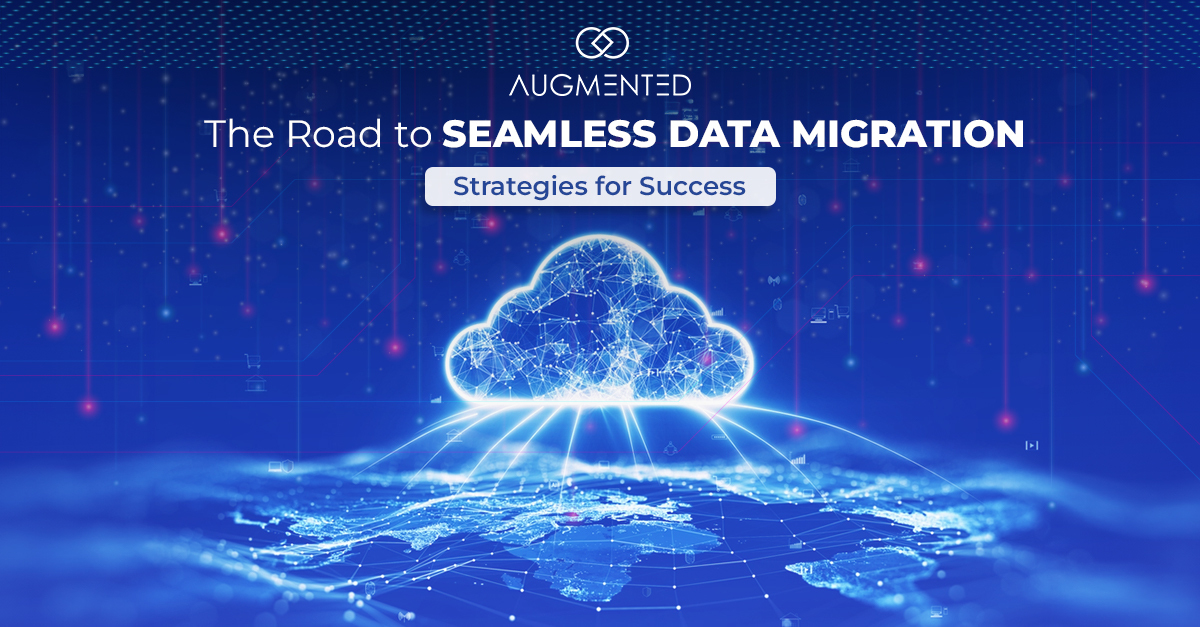Are you ready for your data to be compromised during the transfer? Or will it be okay if downtime hampers your business growth?
Of course not. The sheer thought of data corruption or loss sends chills down the spine.
But these nightmares can be avoided if you strategically move your data. This blog post comprises of six best data migration strategies for a seamless migration.
So, learn how a seamless data migration can help avoid these pitfalls.
What is Data Migration, and Why is Seamless Migration Necessary?
Data migration is the method of transferring data from one place to another. The migration process occurs from the on-premise system to other systems, such as the cloud.
How does cloud migration work? When you move your data from your in-house or private data centers to a public cloud platform, the following few steps are taken:
- Data migration planning and assessing.
- Backing up the data.
- Selecting the right data migration techniques.
- Preparing the Cloud environment.
- Performing the migration.
- Testing and optimizing
Did you know that adopting cloud computing is on the rise? The global market for public cloud computing is expected to reach $679 billion in 2024.
But why does seamless data migration require serious consideration? Let’s have a closer look.
Why is Seamless Migration Necessary?
Data is the goldmine for every business or organization. Imagine your data being lost during the migration process. No business or organization would want that.
Seamless migration is crucial because of many reasons, including:
- When you perform the migration process, data should remain available and accessible throughout the process.
- Seamless data migration minimizes the risk of data corruption or data loss.
Let’s understand the importance of seamless data migration with a simple example.
Example:
Imagine migrating to the cloud after years of using a legacy system, and all data migration process steps have been carefully thought through.
However, during the migration, you experience certain hiccups which disrupt your business. Moreover, your team does not know what to do, and you are on the edge of losing all your precious data.
Now the question is:
Are you willing to lose all the data? Are you ready and prepared for the hiccups? Did you follow a data migration strategy?
If not, the consequences cannot even be imagined. So, to avoid such distress and safely transfer your data to a new system seamless data migration becomes pivotal.
How to do that? Read ahead.
4 Factors to Consider Before Starting Your Data Migration
A smooth migration isn’t magic. Thorough data migration planning is important. So before you hit that “migration” button, here are 4 things you should consider.
1. Conduct an Audit:
Don’t just pack and move. Conduct a comprehensive data audit before data migration planning. Declutter and streamline your data by leaving behind all the duplicate or outdated data before the migration.
2. Let People Know:
It is exciting to switch to a new platform. However, your team and stakeholders must be kept in the loop throughout the migration process. This ensures they get acquainted with the new system easily and are prepared for disruptions.
3. Decide on Your Migration Objectives:
Don’t migrate without setting goals. Set some clear objectives and also share them with your team. Understand the “why” behind the move and plan a roadmap for a successful migration.
4. Choose the Right Provider:
Don't just jump blindfolded from one place to another. Data migration can be a ground-breaking move for your company. But only if the chosen platform is right. So, do your research and find the one that fits your data needs.
A seamless data migration is within your reach—all it takes is the right plan, tools and strategies. Let’s examine the best strategies for achieving a seamless data migration.
6 Strategies for a Seamless Data Migration
With data on the move, solid data migration planning and best practices can make a huge difference.
So, ditch the data migration disaster with these six winning strategies.
1. Make a Plan
Have an effective plan. Why? Because planning is the key to a successful and seamless data migration. A proper plan for the process will help you and your team be prepared for any obstacles or challenges.
- First, identify what data needs to be migrated. For instance, customer information or product details.
- Second, set a timeline with clear milestones. Meanwhile, assign tasks to your team members, such as who does what and when.
- Third, have regular check-ins to keep everyone in the loop.
Having a well-structured plan instills a sense of preparedness and confidence in your team. It helps you course-correct and keeps you ready for any mishappenings.
2. Back-Up Your Data
Sometimes, even after having a proper plan, things may go south. For instance, your data may become corrupt or go missing during migration. So, to avoid any panic during the transfer, data backup is crucial.
Remember that the best backup technique or strategy depends on a lot of factors, such as the size of your data and the data migration techniques. So, consider talking to an expert or an IT professional before backing up your data.
3. Select the Right Migration Tool
Taking the right route to reach your destination is of utmost importance. There are different data migration techniques, but its on you to choose the one that best suits your data volume.
A few questions that you can ask yourself when selecting the right data migration tool:
- What is your destination? Are you migrating to the cloud or a different platform?
- How long will it take to migrate the data?
- Can the tool handle the migration from your on-premise system to the new one?
- Is your data secure during the migration with the tool?
- How much will be the migration cost?
Don’t settle for the first options. Do thorough research on multiple migration tools. When picking a tool, ensure that you are looking for a seamless and secure migration.
4. Conduct a Test
It is not the best plan to jump straight into transferring everything. Don't rush before migrating your data. Test your migration with a "mini-migration." The test will detect problems or errors and help you iron out the hindrances in advance.
You can avoid major issues and move your dataset with minimal downtime or other disruptions with a pre-migration test.
5. Get Ready for the Implementation
It's time to execute. This is when your planning comes to life. You have carefully planned, backed up your data and confirmed that everything works well with a test run.
During the migration process:
- Closely monitor each stage of the process to ensure a smooth transfer.
- Have open and clear communication with everyone involved. Communication can address any hurdles and bumps.
- Keep stakeholders in the loop and inform them about potential disruptions.
- Post migration verify and check the new system for safe, secure and complete data.
Congratulations, you are good to go. You’ve successfully migrated your data to a new place.
6. Review and Monitor
It’s not over yet. After the data migration process is complete, establish a plan for regular check-ups. Perform data audits regularly to review and monitor the data.
You can seek feedback from end users, address issues and monitor data quality.
So, if you are also looking for a seamless data migration, consider implementing these strategies.
Looking for a Seamless Data Migration?
Businesses and organizations can confidently transfer their data without compromising their data integrity. Data migration can be as easy as it sounds by carefully planning, clearly communicating and conducting extensive tests.
At Augmented, we make the move easy. For all types of data migration solutions, schedule a free consultation or book a demo with us today.





